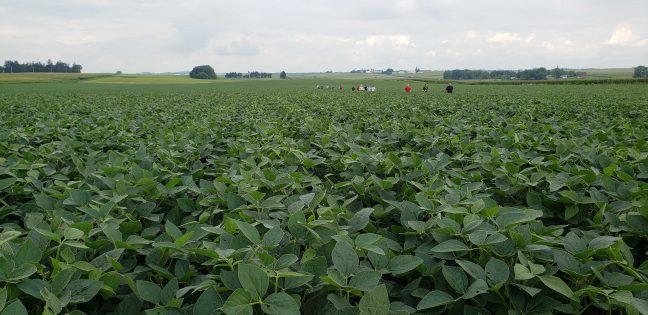A new research initiative led by associate professor of bacteriology Betül Kaçar is positioned to transform agriculture and address some of the world’s most pressing ecological and economic challenges.
Along with co-investigators professor of bacteriology Jean-Michel Ané and professor of chemical and biological engineering Brian Pfleger, their collaborative project seeks to unlock the powerful process of nitrogen fixation, a process that could reduce agriculture’s dependency on synthetic fertilizers while improving sustainability, according a press release.
Kaçar said its important to understand life’s origins to solve modern problems.
“To truly understand life on this planet, we need to understand its beginnings, ” Kaçar said. “We don’t know much about how cellular innovations and evolution occurred over long time scales. This knowledge is crucial for both understanding life as we know it and exploring the potential for life elsewhere.”
By investigating how microbes evolved the ability to fix nitrogen, researchers can not only answer fundamental questions about life’s origins but also apply this knowledge to tackle current environmental issues, Kaçar said.
Nitrogen fixation, which is an essential process for the survival of all living organisms, remains an important part of the research.
“Nitrogen is incredibly abundant in our atmosphere and vital for life on Earth,” Kaçar said. “We have nitrogen in our cells and proteins, but we can’t produce it ourselves. The real question is: how do these plants get their nitrogen?”
The answer lies in a tiny but powerful microbe that can “fix” atmospheric nitrogen into a biologically usable form, which plants can then absorb, Kaçar said.
The key to this process is the enzyme nitrogenase, as the heart of nitrogen fixation, according to Kaçar.
Nitrogenase is believed to be at least 3 billion years old and evolved under conditions that were very different from today’s world, with much higher levels of carbon dioxide and extreme temperatures, Kaçar said.
“The evolution of nitrogen fixation is tied to Earth’s ancient history, and understanding it helps us understand the resilience of life over billions of years,” Kaçar said. “We realize that Earth has endured far worse in the past. It’s actually a hopeful message — life finds a way, and it always has.”
According to Ané, the focus of the project is clear — humans need nitrogen to grow our crops, which require a lot of nitrogen inputs for good yields.
But, since the Green Revolution, many have been too heavily dependent on the Haber-Bosch process, which is used to produce synthetic fertilizers, Ané said.
Fertilizers are costly for growers, and the price of fertilizer is tied to the fluctuating cost of natural gas, but beyond the economic challenge, there are also environmental concerns associated with synthetic fertilizers, Ane said.
“A lot of fertilizers applied in the field are not absorbed by the plants and end up in the groundwater, leading to nitrogen leaching,” Ané said. “This nitrogen then ends up in rivers, streams and ultimately the Gulf of Mexico. Many fertilizers [also] produce greenhouse gases like nitrous oxide, which contribute to climate change.”
In response to these issues, the team is aiming to develop a more sustainable alternative.
The goal of the technology is not to eliminate fertilizers entirely but to replace a fraction of them with bacteria that fix nitrogen from the air and convert it into a usable form, Ané said.
A major component of this research is the use of artificial intelligence and genetic engineering to enhance the capabilities of nitrogen-fixing bacteria.
“AI tools are incredibly helpful for structural predictions, and they allow us to survey a huge number of proteins in ways that were previously impossible,” Kaçar said.
By combining AI with traditional biological techniques, the team hopes to discover new ways to optimize the enzyme nitrogenase and expand its potential applications.
Nitrogenase is essential for nitrogen fixation, but it’s highly sensitive to oxygen, Ané said.
In making nitrogenase less sensitive to oxygen, it could allow the bacteria to fix nitrogen more efficiently, even in environments where oxygen levels would normally inhibit the process, Ané said.
This project is truly interdisciplinary, bringing together researchers from diverse fields such as paleobiology, computational biology, synthetic biology and agronomy, according to the press release.
“I think this is the future — synthesizing different approaches from science, engineering and basic research to tackle big challenges,” Kaçar said.
Ané, for instance, collaborates with companies like Pivot Bio, which produces genetically engineered microbes designed to fix nitrogen and supply it to plants.
His work is focused on bridging the evolutionary research on nitrogenase with practical agricultural applications, Ané said.
Both Kaçar and Ané are quick to recognize the unique role Wisconsin plays in advancing this work.
“Wisconsin is an innovative place, always responding to the needs of the community,” Kaçar said. “There’s no better place to push the frontiers of agricultural research than Wisconsin.”
Their work is supported by the W. M. Keck Foundation, which has funded bold, innovative research on the cusp of taking off, Kaçar said.
The research group is not only addressing the challenges of today but also learning from the resilience of life that has endured for billions of years. The results could have profound implications, not just for agriculture, but for the health of our planet as a whole, Kaçar said.


